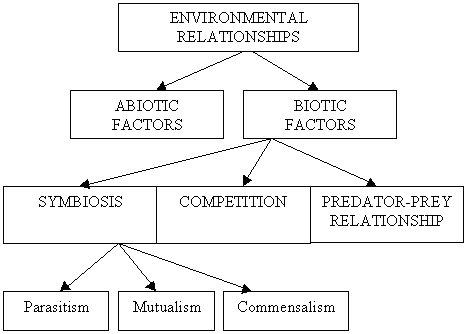Ecology
Common Terms
- Ecology - the study of the interrelationships of living organisms and their environment
- Environment - all the living (biotic) and non-living (abiotic or physical) conditions that act on an organism and affect its chances of survival
- Abiotic Factors - non-living or physical factors e.g. temperature, amount of water, amount of oxygen, amount of light
- Biotic Factors - living factors e.g. amount of food, predators, parasites, competitors
- Community - all the organisms in a particular area at a given time
- Population - the number of a particular species in an area at a specific time
- Habitat - the area in which an organism lives
- Ecosystem - a natural unit of living and non-living parts that interact to produce a stable system in which the exchange of materials between living and non-living parts cycles
- Biome - A biome is a large, easily differentiated community unit arising as a result of complex interactions of climate, other physical factors and biotic factors. Examples of Biomes are tundra, temperate grassland, desert and tropical rainforest.
- Biosphere - The Biosphere is the collective interaction of all the biomes on the Earth.
Relationships in the Environment

- Symbiosis - a relationship in which two organisms of different species 'live together' for a period of time
- Parasitism - a form of symbiosis in which one organism derives nutrients from the second organism which suffers some harm but is usually not killed (e.g. A tick is the parasite that feeds off a dog which is the host.)
- Mutualism - a form of symbiosis in which both organisms help each other (e.g. A remora fish eats the algae and barnacles from the skin of a shark which, in turn, protects the remora.)
- Commensalism - a form of symbiosis in which one organism helps the other organism, but there is no benefit or harm done in return (e.g. A clown fish lives inside a sea anemone and is protected by it. The sea anemone derives no benefit or harm from the relationship.)
- Predator / Prey Relationships - the relationship in which one organism (predator) hunts and eats another (prey) (e.g. lion / antelope)
- Competition - a relationship where two types of organisms compete for the same resource such as food, water, nesting site (e.g. sheep and kangaroos compete for grass)
Populations
- Population - the number of individuals of the same species in a given area at a given area
- Factors affecting Populations
- Available resources (e.g. food, water, shelter)
- Activities of other organisms (e.g. predators, disease-causing parasites)
- Organism's own characteristics (e.g. gestation period, number of young produced, nurturing of young, migratory)
- Time of day or year (e.g. tides, seasons, nocturnal or diurnal)
- Weather (e.g. amount of rainfall, cyclone, drought)
Adaptations
- Adaptation - a characteristic of an organism that enables it to function more effectively or survive in its surroundings
- 5 Types of Adaptations
- Structural - related to the structure of the organism (e.g. The streamlined shape of fish enables it to swim more quickly through water.)
- Colour - related to colour (e.g. camouflage, warning colouration of blue-ringed octopus, mimicry of butterfly wings with 'eye spot')
- Physiological - related to the organism's metabolism (e.g. During hibernation, bears reduce their chemical processes.)
- Behavioural - related to behaviour (e.g. During the heat of the day in the desert, lizards burrow into the sand to find a cooler place.)
- Reproductive - related to courtship, mating or rearing of young (e.g. Peacocks fan their feathers to attract a mate.)